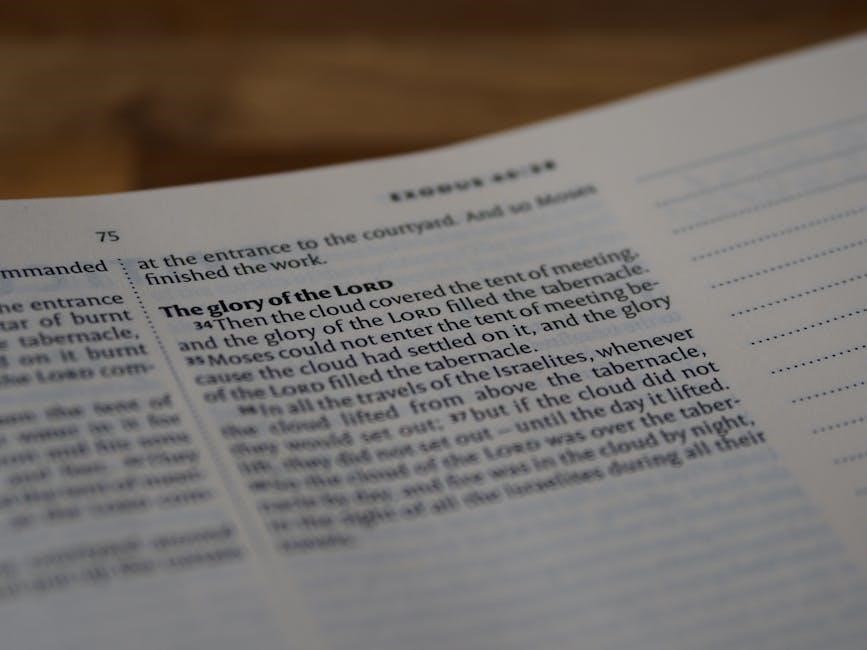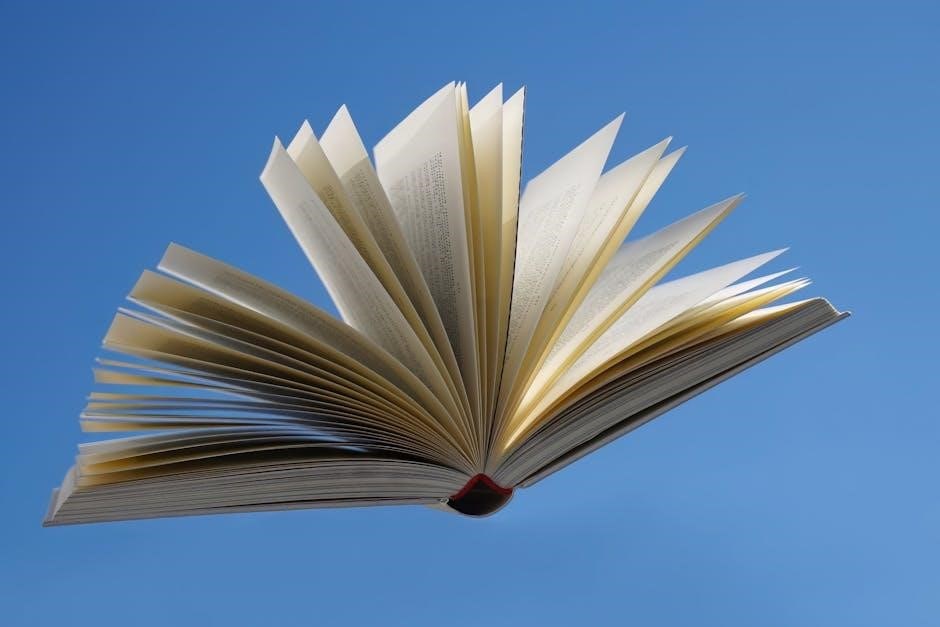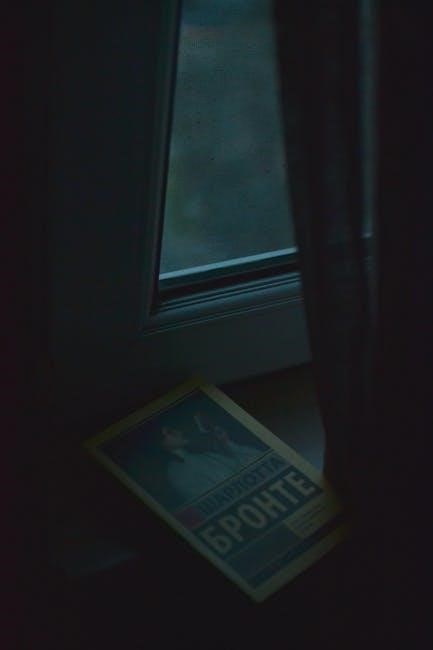William Golding’s Lord of the Flies is a thought-provoking novel exploring human nature, civilization, and savagery through the story of boys stranded on a mysterious island.
Overview of the Novel
Lord of the Flies, written by William Golding, is a gripping tale of survival and human nature. Published in 1954, the novel follows a group of British boys stranded on a mysterious island after a plane crash. With no adult supervision, the boys initially attempt to create a civilized society but gradually descend into chaos and savagery. The story explores themes of morality, power, and the primal instincts that emerge when societal norms are stripped away.
Author Background: William Golding
William Golding (1911–1993) was a British novelist, playwright, and poet, best known for Lord of the Flies. Born in Cornwall, England, Golding developed a passion for literature early in life. Before becoming a full-time writer, he worked as a teacher and served in the Royal Navy during World War II. His experiences shaped his deep insight into human nature, which is reflected in his works. Golding’s writing often explores themes of morality, survival, and the darker aspects of human behavior.
Publication and Reception

Lord of the Flies was published in 1954 by William Golding, marking his debut as a novelist. Initially, the book received mixed reviews due to its dark and unsettling themes, but it quickly gained popularity for its thought-provoking narrative. Over 20 million copies have been sold worldwide, making it a literary classic. The novel’s exploration of human nature resonated with readers, solidifying its place in modern literature. Its controversial themes have sparked debates, yet its relevance continues to grow, ensuring its enduring legacy.
Themes and Symbolism in “Lord of the Flies”
The novel explores themes of human nature, civilization, and savagery, using symbols like the conch shell, the beast, and the island to convey moral and philosophical ideas.
The Use of Light and Dark Imagery
Golding employs light and dark imagery to symbolize good versus evil and civilization versus savagery. Light, such as the conch shell and fire, represents order and democracy, while darkness, like the jungle and the beast, signifies fear and chaos. This contrast underscores the boys’ descent into primal behavior, highlighting the loss of innocence and the emergence of inherent human darkness. The imagery reinforces the novel’s central themes of morality and the duality of human nature.
Existential Motives and Symbolic Varieties
Golding’s novel delves into existential themes, exploring human nature’s complexity through symbolic elements. The conch shell represents democracy and order, while the pig’s head embodies the primal forces of savagery. The “beast” symbolizes the boys’ deep-seated fears and the unknown, reflecting existential anxieties. These symbols illustrate the struggle between civility and inherent darkness, highlighting the novel’s exploration of identity, morality, and the human condition in isolation.
Moral and Philosophical Questions
Lord of the Flies raises profound moral and philosophical questions about human nature, ethics, and societal norms. The novel explores how isolation and fear lead to moral decay, challenging the idea of inherent human goodness. The boys’ descent into savagery prompts reflections on civilization’s thin veneer and the primal instincts that lie beneath. Golding’s work questions whether morality is innate or learned, sparking debates about humanity’s capacity for both good and evil in the absence of societal constraints.

Plot Summary and Key Chapters
Lord of the Flies tells the story of boys stranded on an island after a plane crash, exploring their struggle for survival, power, and morality through key chapters;
Chapter 1: The Sound of the Shell
In this opening chapter, William Golding introduces a group of boys stranded on a mysterious island after a plane crash. The story begins with Ralph, a fair-haired boy, discovering a conch shell, which becomes a symbol of order and democracy. The boys gather, and Ralph is elected leader, with Jack as his rival. The chapter sets the tone for the novel, showcasing the island’s beauty and the boys’ initial innocence, while hinting at underlying tensions and the challenges ahead;
- The conch shell represents unity and civility among the boys.
- Ralph and Jack’s leadership rivalry is introduced.
- The island’s eerie yet enchanting atmosphere is established.
Chapter 2: Fire on the Mountain
In this chapter, the boys’ excitement and fear grow as they attempt to signal for rescue by lighting a fire on the mountain. Tensions rise between Ralph and Jack, as their differing priorities—building shelters versus hunting—begin to clash. The fire, initially a symbol of hope, becomes chaotic and destructive, foreshadowing the boys’ descent into savagery. The chapter highlights the fragility of their newfound society and the challenges of maintaining order without adult supervision.
- Ralph and Jack’s leadership conflict intensifies.
- The fire symbolizes both hope and impending chaos.
- The boys’ behavior becomes more erratic and primal.
Chapter 3: Huts on the Beach
In this chapter, the boys focus on building huts, showcasing their initial attempts at creating a civilized society. Ralph emphasizes the importance of shelters, while Jack’s obsession with hunting grows. The chapter highlights the boys’ resourcefulness but also reveals their underlying fears and vulnerabilities. As night falls, the group fears a “beast,” signaling the start of paranoia and superstition that will escalate tensions. The huts symbolize their fragile attempts at order in an increasingly chaotic environment.
- The boys’ efforts to build shelters reflect their desire for safety.
- Fears of a mysterious “beast” begin to surface.
- Ralph and Jack’s differing priorities create early friction.
Characters and Their Roles
The novel features Ralph, Jack, Piggy, and the choirboys, each representing distinct aspects of human nature. Their roles drive the story’s exploration of leadership, savagery, and innocence.
Ralph and His Leadership
Ralph, the protagonist, embodies civility and democracy. Elected as the leader, he uses the conch shell to maintain order and ensure everyone’s voice is heard. His vision of building shelters and maintaining a signal fire reflects his practicality and responsibility. However, as the novel progresses, Ralph’s leadership is challenged by Jack’s desire for power, leading to internal conflicts and the eventual decline of his authority. His character represents the struggle between order and chaos in human nature.
Jack’s Transformation and Ambition
Jack Merridale’s transformation from a choirboy to a power-hungry leader is central to the novel. Initially, he is eager to follow rules but soon becomes consumed by his desire to hunt. His ambition for dominance grows, leading him to form his own tribe and embrace savagery. Jack’s descent into brutality symbolizes the innate human tendency toward violence and the erosion of moral boundaries when authority is unchecked. His character contrasts sharply with Ralph’s civility, highlighting themes of power and corruption.
Piggy’s Intelligence and Innocence

Piggy, with his intellectual brilliance and naive optimism, represents reason and morality. His glasses symbolize clarity and wisdom, while his asthma underscores his physical vulnerability. Despite his outsider status, Piggy’s logical thinking and loyalty to Ralph highlight his innocence. His tragic demise embodies the loss of innocence and the collapse of civility on the island. Piggy’s character serves as a poignant reminder of the fragility of intelligence and goodness in the face of primal instincts and chaos.

Reception and Controversy
Lord of the Flies sparks intense debate due to its dark themes, brutal realism, and controversial motifs, leading to bans in some regions while maintaining its acclaim as a literary masterpiece.
Critical Acclaim and Popularity
Lord of the Flies is a literary masterpiece, widely praised for its profound exploration of human nature. Over twenty million copies have been sold worldwide, making it a timeless classic. William Golding’s work earned him the Nobel Prize in Literature, solidifying its global acclaim. The novel’s thought-provoking themes and gripping narrative continue to resonate with readers, ensuring its relevance in modern literature and media. Its popularity endures, sparking discussions and debates across generations.
Controversial Themes and Bans
Lord of the Flies has faced controversy due to its dark and brutal portrayal of human nature. Themes of violence, savagery, and moral decay have led to bans in some schools and libraries, with critics labeling it pessimistic and inappropriate for younger audiences. Despite this, its exploration of societal breakdown and primal instincts continues to spark debates, making it a highly discussed and thought-provoking work in literary circles and educational settings worldwide.
Adaptations and Cultural Impact
Lord of the Flies is set to be adapted into a television series, marking its first TV adaptation. Its dark themes and moral questions continue to resonate globally, influencing literature and society significantly.
Upcoming Television Series
A television series adaptation of Lord of the Flies is in development, marking its first TV adaptation since publication. Acclaimed screenwriter Jack Thorne, known for his BAFTA-winning work, will bring William Golding’s iconic story to life. Produced by Eleven, the series aims to capture the novel’s dark themes and moral complexity, introducing the story to a new generation. This adaptation promises to reignite global interest in Golding’s timeless exploration of human nature and society.
Significance in Modern Media
Lord of the Flies remains a cultural cornerstone, influencing films, literature, and social commentary. Its exploration of human nature, morality, and societal collapse continues to resonate, making it a frequent reference in modern discourse. The novel’s themes of power, fear, and civilization’s fragility are timeless, ensuring its relevance in contemporary media and intellectual discussions. Its enduring popularity highlights its universal appeal, solidifying its place as a landmark work in 20th-century literature and beyond.

Availability and PDF Version
William Golding’s Lord of the Flies is widely available, including a convenient PDF version, making it easily accessible for modern readers worldwide.
Downloading the PDF Legally
Lord of the Flies in PDF format is readily available for legal download through authorized platforms like Amazon, Google Books, and official publishers. Ensure you purchase or access it from reputable sources to avoid piracy. This digital version offers convenience, allowing readers to enjoy William Golding’s timeless classic on various devices. Legal downloads support authors and publishers, preserving the value of literary works for future generations.
Benefits of Reading the Digital Version
The digital version of Lord of the Flies offers enhanced readability and convenience. With adjustable font sizes and night modes, it ensures a comfortable reading experience. The PDF format allows easy access on multiple devices, making it ideal for on-the-go readers. Additionally, digital copies often include interactive features like bookmarks and search functions, enhancing study and reference capabilities. This modern format breathes new life into William Golding’s classic, catering to today’s tech-savvy audience while preserving the novel’s profound themes and messages.
Lord of the Flies remains a timeless exploration of humanity, with its PDF version offering accessibility and convenience for modern readers to engage with Golding’s profound themes.
Final Thoughts on the Novel’s Relevance
Lord of the Flies continues to resonate as a powerful allegory of human nature, civilization, and inherent darkness. Its themes of leadership, morality, and societal collapse remain universally relevant, making it a cornerstone of modern literature. The availability of the novel in PDF format ensures its accessibility to new generations, allowing readers to engage with Golding’s profound insights into humanity’s duality. Its enduring popularity underscores its importance as a thought-provoking and timeless classic.

Impact on Literature and Society
Lord of the Flies has profoundly influenced literature and society, challenging perceptions of human nature and civilization. Its exploration of primal instincts and moral decay has inspired countless adaptations and discussions. The novel’s themes of power, fear, and savagery resonate across cultures, making it a pivotal work in modern literary discourse. Its adaptation into a television series further cements its relevance, ensuring its message continues to provoke thought and spark conversations about humanity’s darker tendencies and societal structures.
